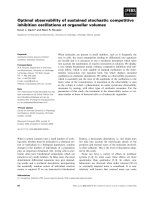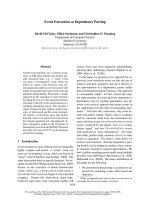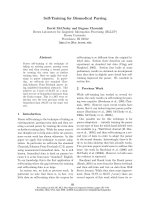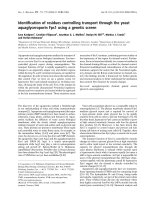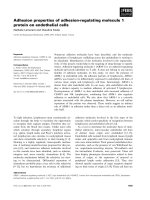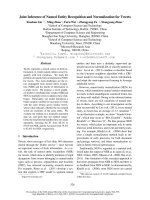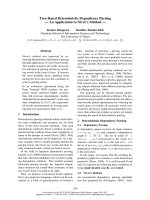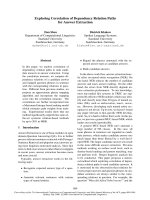Báo cáo khoa học: "Joint Training of Dependency Parsing Filters through Latent Support Vector Machines" pptx
Bạn đang xem bản rút gọn của tài liệu. Xem và tải ngay bản đầy đủ của tài liệu tại đây (250.55 KB, 6 trang )
Proceedings of the 49th Annual Meeting of the Association for Computational Linguistics:shortpapers, pages 200–205,
Portland, Oregon, June 19-24, 2011.
c
2011 Association for Computational Linguistics
Joint Training of Dependency Parsing Filters through
Latent Support Vector Machines
Colin Cherry
Institute for Information Technology
National Research Council Canada
Shane Bergsma
Center for Language and Speech Processing
Johns Hopkins University
Abstract
Graph-based dependency parsing can be sped
up significantly if implausible arcs are elim-
inated from the search-space before parsing
begins. State-of-the-art methods for arc fil-
tering use separate classifiers to make point-
wise decisions about the tree; they label tokens
with roles such as root, leaf, or attaches-to-
the-left, and then filter arcs accordingly. Be-
cause these classifiers overlap substantially in
their filtering consequences, we propose to
train them jointly, so that each classifier can
focus on the gaps of the others. We inte-
grate the various pointwise decisions as latent
variables in a single arc-level SVM classifier.
This novel framework allows us to combine
nine pointwise filters, and adjust their sensi-
tivity using a shared threshold based on arc
length. Our system filters 32% more arcs than
the independently-trained classifiers, without
reducing filtering speed. This leads to faster
parsing with no reduction in accuracy.
1 Introduction
A dependency tree represents syntactic relationships
between words using directed arcs (Me
´
l
ˇ
cuk, 1987).
Each token in the sentence is a node in the tree,
and each arc connects a head to its modifier. There
are two dominant approaches to dependency pars-
ing: graph-based and transition-based, where graph-
based parsing is understood to be slower, but often
more accurate (McDonald and Nivre, 2007).
In the graph-based setting, a complete search
finds the highest-scoring tree under a model that de-
composes over one or two arcs at a time. Much of
the time for parsing is spent scoring each poten-
tial arc in the complete dependency graph (John-
son, 2007), one for each ordered word-pair in the
sentence. Potential arcs are scored using rich linear
models that are discriminatively trained to maximize
parsing accuracy (McDonald et al., 2005). The vast
majority of these arcs are bad; in an n-word sen-
tence, only n of the n
2
potential arcs are correct. If
many arcs can be filtered before parsing begins, then
the entire process can be sped up substantially.
Previously, we proposed a cascade of filters to
prune potential arcs (Bergsma and Cherry, 2010).
One stage of this cascade operates one token at a
time, labeling each token t according to various roles
in the tree:
• Not-a-head (NaH ): t is not the head of any arc
• Head-to-left (HtL{1/5/*}): t’s head is to its
left within 1, 5 or any number of words
• Head-to-right (HtR{1/5/*}): as head-to-left
• Root (Root): t is the root node, which elimi-
nates arcs according to projectivity
Similar to Roark and Hollingshead (2008), each role
has a corresponding binary classifier. These token-
role classifiers were shown to be more effective than
vine parsing (Eisner and Smith, 2005; Dreyer et
al., 2006), a competing filtering scheme that filters
arcs based on their length (leveraging the observa-
tion that most dependencies are short).
In this work, we propose a novel filtering frame-
work that integrates all the information used in
token-role classification and vine parsing, but of-
fers a number of advantages. In our previous work,
classifier decisions would often overlap: different
token-role classifiers would agree to filter the same
arc. Based on this observation, we propose a joint
training framework where only the most confident
200
HtR1
6
&
NaH
3
& HtR*
6
&
HtR5
6
&
Bob
1&
ate
2
& the
3
& pizza
4
& with
5
& his
6
& fork
8
&&
NN& VBD& DT& NN& IN& POS& NN&
HtL1
6
&
salad
7
&
NN&
(T)&
(T)&
(T)&
(F)&
(F)&
Figure 1: The dotted arc can be filtered by labeling any of the
boxed roles as True; i.e., predicting that the head the
3
is not the
head of any arc, or that the modifier his
6
attaches elsewhere.
Role truth values, derived from the gold-standard tree (in grey),
are listed adjacent to the boxes, in parentheses.
classifier is given credit for eliminating an arc. The
identity of the responsible classifier is modeled as
a latent variable, which is filled in during training
using a latent SVM (LSVM) formulation. Our use
of an LSVM to assign credit during joint training
differs substantially from previous LSVM applica-
tions, which have induced latent linguistic structures
(Cherry and Quirk, 2008; Chang et al., 2010) or sen-
tence labels (Yessenalina et al., 2010).
In our framework, each classifier learns to fo-
cus on the cases where the other classifiers are less
confident. Furthermore, the integrated approach di-
rectly optimizes for arc-filtering accuracy (rather
than token-labeling fidelity). We trade-off filtering
precision/recall using two hyperparameters, while
the previous approach trained classifiers for eight
different tasks resulting in sixteen hyperparameters.
Ultimately, the biggest gains in filter quality are
achieved when we jointly train the token-role classi-
fiers together with a dynamic threshold that is based
on arc length and shared across all classifiers.
2 Joint Training of Token Roles
In our previous system, filtering is conducted by
training a separate SVM classifier for each of the
eight token-roles described in Section 1. Each clas-
sifier uses a training set with one example per tree-
bank token, where each token is assigned a binary
label derived from the gold-standard tree. Figure 1
depicts five of the eight token roles, along with their
truth values. The role labelers can be tuned for high
precision with label-specific cost parameters; these
are tuned separately for each classifier. At test time,
each of the eight classifiers assigns a binary label
to each of the n tokens in the sentence. Potential
arcs are then filtered from the complete dependency
graph according to these token labels. In Figure 1,
a positive assignment to any of the indicated token-
roles is sufficient to filter the dotted arc.
In the current work, we maintain almost the same
test-time framework, but we alter training substan-
tially, so that the various token-role classifiers are
trained jointly. To do so, we propose a classifica-
tion scheme focused on arcs.
1
During training, each
arc is assigned a filtering event as a latent variable.
Events generalize the token-roles from our previous
system (e.g. NaH
3
, HtR∗
6
). Events are assigned bi-
nary labels during filtering; positive events are said
to be detected. In general, events can correspond
to any phenomenon, so long as the following holds:
For each arc a, we must be able to deterministically
construct the set Z
a
of all events that would filter
a if detected.
2
Figure 1 shows that Z
the
3
→his
6
=
{NaH
3
, HtR∗
6
, HtR5
6
, HtR1
6
, HtL1
6
}.
To detect events, we maintain the eight token-role
classifiers from the previous system, but they be-
come subclassifiers of our joint system. For no-
tational convenience, we pack them into a single
weight vector ¯w. Thus, the event z = NaH
3
is de-
tected only if ¯w ·
¯
Φ(NaH
3
) > 0, where
¯
Φ(z) is z’s
feature vector. Given this notation, we can cast the
filtering decision for an arc a as a maximum. We
filter a only if:
f(Z
a
) > 0 where f(Z
a
) = max
z∈Z
a
¯w ·
¯
Φ(z)
(1)
We have reformulated our problem, which previ-
ously involved a number of independent token clas-
sifiers, as a single arc classifier f() with an inner max
over latent events. Note the asymmetry inherent in
(1). To filter an arc,
¯w ·
¯
Φ(z) > 0
must hold for at
least one z ∈ Z
a
; but to keep an arc,
¯w ·
¯
Φ(z) ≤ 0
must hold for all z ∈ Z
a
. Also note that tokens
have completely disappeared from our formalism:
the classifier is framed only in terms of events and
arcs; token-roles are encapsulated inside events.
To provide a large-margin training objective for
our joint classifier, we adapt the latent SVM (Felzen-
1
A joint filtering formalism for CFG parsing or SCFG trans-
lation would likewise focus on hyper-edges or spans.
2
This same requirement is also needed by the previous,
independently-trained filters at test time, so that arcs can be fil-
tered according to the roles assigned to tokens.
201
szwalb et al., 2010; Yu and Joachims, 2009) to our
problem. Given a training set A of (a, y) pairs,
where a is an arc in context and y is the correct filter
label for a (1 to filter, 0 otherwise), LSVM training
selects ¯w to minimize:
1
2
|| ¯w||
2
+
(a,y)∈A
C
y
max
0, 1 + f(Z
a|¬y
) − f(Z
a|y
)
(2)
where C
y
is a label-specific regularization parame-
ter, and the event set Z is now conditioned on the
label y: Z
a|1
= Z
a
, and Z
a|0
= {None
a
}. None
a
is a rejection event, which indicates that a is not
filtered. The rejection event slightly alters our de-
cision rule; rather than thresholding at 0, we now
filter a only if f(Z
a
) > ¯w ·
¯
Φ(None
a
). One can set
¯
Φ(None
a
) ← ∅ for all a to fix the threshold at 0.
Though not convex, (2) can be solved to a lo-
cal minimum with an EM-like alternating minimiza-
tion procedure (Felzenszwalb et al., 2010; Yu and
Joachims, 2009). The learner alternates between
picking the highest-scoring latent event ˆz
a
∈ Z
a|y
for each example (a, y), and training a multiclass
SVM to solve an approximation to (2) where Z
a|y
is
replaced with {ˆz
a
}. Intuitively, the first step assigns
the event ˆz
a
to a, making ˆz
a
responsible for a’s ob-
served label. The second step optimizes the model to
ensure that each ˆz
a
is detected, leading to the desired
arc-filtering decisions. As the process iterates, event
assignment becomes increasingly refined, leading to
a more accurate joint filter.
The resulting joint filter has only two hyper-
parameters: the label-specific cost parameters C
1
and C
o
. These allow us to tune our system for high
precision by increasing the cost of misclassifying an
arc that should not be filtered (C
1
C
o
).
Joint training also implicitly affects the relative
costs of subclassifier decisions. By minimizing an
arc-level hinge loss with latent events (which in turn
correspond to token-roles), we assign costs to token-
roles based on arc accuracy. Consequently, 1) A
token-level decision that affects multiple arcs im-
pacts multiple instances of hinge loss, and 2) No
extra credit (penalty) is given for multiple decisions
that (in)correctly filter the same arc. Therefore, an
NaH decision that filters thirty arcs is given more
weight than an HtL5 decision that filters only one
(Item 1), unless those thirty arcs are already filtered
NaH
3
%=%0.5%%
The
1
% big
2
% dog
3
% chased
4
% the
5
% cat
6
%
DT% ADJ% NN% VBD% DT% NN%
1.0%% 1.1%% 0.6% 0.3% 0.2%
Figure 2: A hypothetical example of dynamic threshold-
ing, where a weak assertion that dog
3
should not be a head
`
¯w ·
¯
Φ(NaH
3
) = 0.5
´
is sufficient to rule out two arcs. Each
arc’s threshold
`
¯w ·
¯
Φ(None
a
)
´
is shown next to its arrow.
by higher-scoring subclassifiers (Item 2).
3 Accounting for Arc Length
We can extend our system by expanding our event
set Z. By adding an arc-level event Vine
a
to each
Z
a
, we can introduce a vine filter to prune long arcs.
Similarly, we have already introduced another arc-
level event, the rejection event None
a
. By assign-
ing features to None
a
, we learn a dynamic thresh-
old on all filters, which considers properties of the
arc before acting on any other event. We parameter-
ize both Vine
a
and None
a
with the same two fea-
tures, inspired by tag-specific vine parsing (Eisner
and Smith, 2005):
Bias : 1
HeadTag
ModTag Dir(a) : Len(a)
where HeadTag ModTag Dir(a) concatenates the
part-of-speech tags of a’s head and modifier tokens
to its direction (left or right), and Len(a) gives the
unsigned distance between a’s head and modifier.
In the context of Vine
a
, these two features al-
low the system to learn tag-pair-specific limits on
arc length. In the context of None
a
, these features
protect short arcs and arcs that connect frequently-
linked tag-pairs, allowing our token-role filters to be
more aggressive on arcs that do not have these char-
acteristics. The dynamic threshold also alters our
interpretation of filtering events: where before they
were either active or inactive, events are now as-
signed scores, which are compared with the thresh-
old to make final filtering decisions (Figure 2).
3
3
Because tokens and arcs are scored independently and cou-
pled only through score comparison, the impact of Vine
a
and
None
a
on classification speed should be no greater than doing
vine and token-role filtering in sequence. In practice, it is no
slower than running token-role filtering on its own.
202
4 Experiments
We extract dependency structures from the Penn
Treebank using the head rules of Yamada and Mat-
sumoto (2003).
4
We divide the Treebank into train
(sections 2–21), development (22) and test (23). We
part-of-speech tag our data using a perceptron tagger
similar to the one described by Collins (2002). The
training set is tagged with jack-knifing: the data is
split into 10 folds and each fold is tagged by a sys-
tem trained on the other 9 folds. Development and
test sets are tagged using the entire training set.
We train our joint filter using an in-house latent
SVM framework, which repeatedly calls a multi-
class exponentiated gradient SVM (Collins et al.,
2008). LSVM training was stopped after 4 itera-
tions, as determined during development.
5
For the
token-role classifiers, we re-implement the Bergsma
and Cherry (2010) feature set, initializing ¯w with
high-precision subclassifiers trained independently
for each token-role. Vine and None subclassifiers
are initialized with a zero vector. At test time, we
extract subclassifiers from the joint weight vector,
and use them as parameters in the filtering tools of
Bergsma and Cherry (2010).
6
Parsing experiments are carried out using the
MST parser (McDonald et al., 2005),
7
which we
have modified to filter arcs before carrying out fea-
ture extraction. It is trained using 5-best MIRA
(Crammer and Singer, 2003).
Following Bergsma and Cherry (2010), we mea-
sure intrinsic filter quality with reduction, the pro-
portion of total arcs removed, and coverage, the pro-
portion of true arcs retained. For parsing results, we
present dependency accuracy, the percentage of to-
kens that are assigned the correct head.
4.1 Impact of Joint Training
Our technical contribution consists of our proposed
joint training scheme for token-role filters, along
4
As implemented at />∼
nivre/
research/Penn2Malt.html
5
The LSVM is well on its way to convergence: fewer than
3% of arcs have event assignments that are still in flux.
6
Since our
contribution is mainly in better filter training, we were able to
use the arcfilter (testing) code with only small changes. We have
added our new joint filter, along with the Joint P1 model to the
arcfilter package, labeled as ultra filters.
7
/>Indep. Joint
System Cov. Red. Cov. Red.
Token 99.73 60.5 99.71 59.0
+ Vine 99.62 68.6 99.69 63.3
+ None N/A 99.76 71.6
Table 1: Ablation analysis of intrinsic filter quality.
with two extensions: the addition of vine filters
(Vine) and a dynamic threshold (None). Using pa-
rameters determined to perform well during devel-
opment,
8
we examine test-set performance as we in-
corporate each of these components. For the token-
role and vine subclassifiers, we compare against an
independently-trained ensemble of the same classi-
fiers.
9
Note that None cannot be trained indepen-
dently, as its shared dynamic threshold considers arc
and token views of the data simultaneously. Results
are shown in Table 1.
Our complete system outperforms all variants in
terms of both coverage and reduction. However, one
can see that neither joint system is able to outper-
form its independently-trained counter-part without
the dynamic threshold provided by None. This is
because the desirable credit-assignment properties
of our joint training procedure are achieved through
duplication (Zadrozny et al., 2003). That is, the
LSVM knows that a specific event is important be-
cause it appears in event sets Z
a
for many arcs from
the same sentence. Without None , the filtering deci-
sions implied by each copy of an event are identical.
Because these replicated events are associated with
arcs that are presented to the LSVM as independent
examples, they appear to be not only important, but
also low-variance, and therefore easy. This leads to
overfitting. We had hoped that the benefits of joint
training would outweigh this drawback, but our re-
sults show that they do not. However, in addition to
its other desirable properties (protecting short arcs),
the dynamic threshold imposed by None restores in-
dependence between arcs that share a common event
(Figure 2). This alleviates overfitting and enables
strong performance.
8
C
0
=1e-2, C
1
=1e-5
9
Each subclassifier is a token-level SVM trained with token-
role labels extracted from the training treebank. Using develop-
ment data, we search over regularization parameters so that each
classifier yields more than 99.93% arc-level coverage.
203
Filter Intrinsic MST-1 MST-2
Filter Cov. Red. Time Acc. Sent/sec* Acc. Sent/sec*
None 100.00 00.0 0s 91.28 16 92.05 10
B&C R+L 99.70 54.1 7s 91.24 29 92.00 17
Joint P1 99.76 71.6 7s 91.28 38 92.06 22
B&C R+L+Q 99.43 78.3 19s 91.23 35 91.98 22
Joint P2 99.56 77.9 7s 91.29 44 92.05 25
Table 2: Parsing with jointly-trained filters outperforms independently-trained filters (R+L), as well as a more complex
cascade (R+L+Q). *Accounts for total time spent parsing and applying filters, averaged over five runs.
4.2 Comparison to the state of the art
We directly compare our filters to those of Bergsma
and Cherry (2010) in terms of both intrinsic fil-
ter quality and impact on the MST parser. The
B&C system consists of three stages: rules (R), lin-
ear token-role filters (L) and quadratic arc filters
(Q). The Q stage uses rich arc-level features simi-
lar to those of the MST parser. We compare against
independently-trained token-role filters (R+L), as
well as the complete cascade (R+L+Q), using the
models provided online.
10
Our comparison points,
Joint P1 and P2 were built by tuning our complete
joint system to roughly match the coverage values
of R+L and R+L+Q on development data.
11
Results
are shown in Table 2.
Comparing Joint P1 to R+L, we can see that for
a fixed set of pointwise filters, joint training with
a dynamic threshold outperforms independent train-
ing substantially. We achieve a 32% improvement
in reduction with no impact on coverage and no in-
crease in filtering overhead (time).
Comparing Joint P2 to R+L+Q, we see that Joint
P2 achieves similar levels of reduction with far less
filtering overhead; our filters take only 7 seconds
to apply instead of 19. This increases the speed of
the (already fast) filtered MST-1 parser from 35 sen-
tences per second to 44, resulting in a total speed-
up of 2.75 with respect to the unfiltered parser. The
improvement is less impressive for MST-2, where
the overhead for filter application is a less substan-
tial fraction of parsing time; however, our training
framework also has other benefits with respect to
R+L+Q, including a single unified training algo-
10
Results are not identical to those reported in our previous
paper, due to our use of a different part-of-speech tagger. Note
that parsing accuracies for the B&C systems have improved.
11
P1: C
0
=1e-2, C
1
=1e-5, P2: C
0
=1e-2, C
1
=2e-5
rithm, fewer hyper-parameters and a smaller test-
time memory footprint. Finally, the jointly trained
filters have no impact on parsing accuracy, where
both B&C filters have a small negative effect.
The performance of Joint-P2+MST-2 is compa-
rable to the system of Huang and Sagae (2010),
who report a parsing speed of 25 sentences per
second and an accuracy of 92.1 on the same test
set, using a transition-based parser enhanced with
dynamic-programming state combination.
12
Graph-
based and transition-based systems tend to make dif-
ferent types of errors (McDonald and Nivre, 2007).
Therefore, having fast, accurate parsers for both ap-
proaches presents an opportunity for large-scale, ro-
bust parser combination.
5 Conclusion
We have presented a novel use of latent SVM
technology to train a number of filters jointly,
with a shared dynamic threshold. By training a
family of dependency filters in this manner, each
subclassifier focuses on the examples where it is
most needed, with our dynamic threshold adjust-
ing filter sensitivity based on arc length. This al-
lows us to outperform a 3-stage filter cascade in
terms of speed-up, while also reducing the im-
pact of filtering on parsing accuracy. Our filter-
ing code and trained models are available online at
In
the future, we plan to apply our joint training tech-
nique to other rich filtering regimes (Zhang et al.,
2010), and to other NLP problems that combine the
predictions of overlapping classifiers.
12
The usual caveats for cross-machine, cross-implementation
speed comparisons apply.
204
References
Shane Bergsma and Colin Cherry. 2010. Fast and accu-
rate arc filtering for dependency parsing. In COLING.
Ming-Wei Chang, Dan Goldwasser, Dan Roth, and Vivek
Srikumar. 2010. Discriminative learning over con-
strained latent representations. In HLT-NAACL.
Colin Cherry and Chris Quirk. 2008. Discriminative,
syntactic language modeling through latent SVMs. In
AMTA.
Michael Collins, Amir Globerson, Terry Koo, Xavier
Carreras, and Peter L. Bartlett. 2008. Exponentiated
gradient algorithms for conditional random fields and
max-margin markov networks. JMLR, 9:1775–1822.
Michael Collins. 2002. Discriminative training methods
for hidden markov models: Theory and experiments
with perceptron algorithms. In EMNLP.
Koby Crammer and Yoram Singer. 2003. Ultraconserva-
tive online algorithms for multiclass problems. JMLR,
3:951–991.
Markus Dreyer, David A. Smith, and Noah A. Smith.
2006. Vine parsing and minimum risk reranking for
speed and precision. In CoNLL.
Jason Eisner and Noah A. Smith. 2005. Parsing with soft
and hard constraints on dependency length. In IWPT.
Pedro F. Felzenszwalb, Ross B. Girshick, David
McAllester, and Deva Ramanan. 2010. Object detec-
tion with discriminatively trained part based models.
IEEE Transactions on Pattern Analysis and Machine
Intelligence, 32(9).
Liang Huang and Kenji Sagae. 2010. Dynamic program-
ming for linear-time incremental parsing. In ACL.
Mark Johnson. 2007. Transforming projective bilexical
dependency grammars into efficiently-parsable CFGs
with unfold-fold. In ACL.
Ryan McDonald and Joakim Nivre. 2007. Characteriz-
ing the errors of data-driven dependency parsing mod-
els. In EMNLP-CoNLL.
Ryan McDonald, Koby Crammer, and Fernando Pereira.
2005. Online large-margin training of dependency
parsers. In ACL.
Igor A. Me
´
l
ˇ
cuk. 1987. Dependency syntax: theory and
practice. State University of New York Press.
Brian Roark and Kristy Hollingshead. 2008. Classifying
chart cells for quadratic complexity context-free infer-
ence. In COLING.
Hiroyasu Yamada and Yuji Matsumoto. 2003. Statistical
dependency analysis with support vector machines. In
IWPT.
Ainur Yessenalina, Yisong Yue, and Claire Cardie. 2010.
Multi-level structured models for document-level sen-
timent classification. In EMNLP.
Chun-Nam John Yu and Thorsten Joachims. 2009.
Learning structural SVMs with latent variables. In
ICML.
Bianca Zadrozny, John Langford, and Naoki Abe. 2003.
Cost-sensitive learning by cost-proportionate example
weighting. In Third IEEE International Conference on
Data Mining.
Yue Zhang, Byung-Gyu Ahn, Stephen Clark, Curt Van
Wyk, James R. Curran, and Laura Rimell. 2010.
Chart pruning for fast lexicalised-grammar parsing. In
EMNLP.
205
